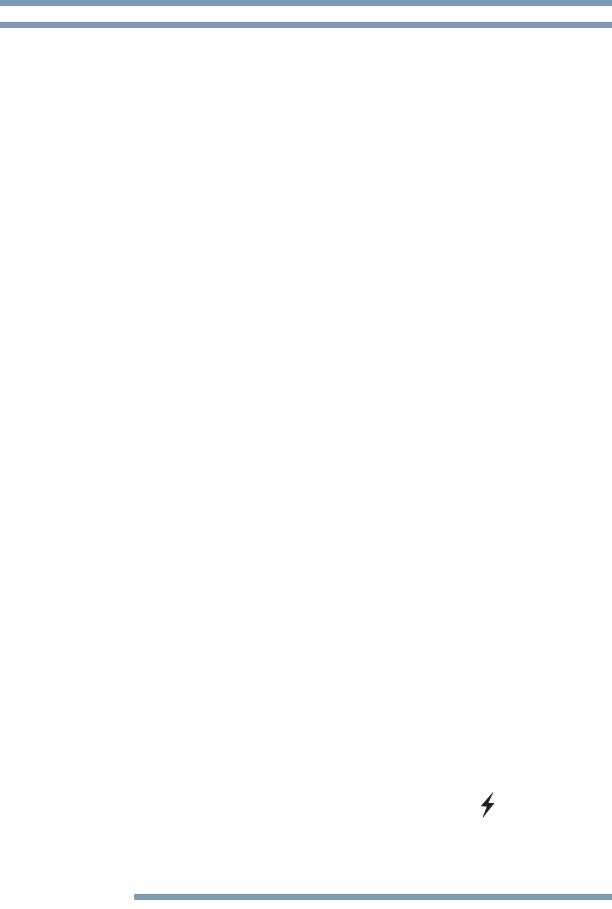Computer Drive User Manual
Table Of Contents
- Portégé® R700 Series User’s Guide
- Contents
- Introduction
- Chapter 1: Getting Started
- Selecting a place to work
- Setting up your computer
- Connecting to a power source
- Charging the main battery
- Using the computer for the first time
- Registering your computer with Toshiba
- Adding optional external devices
- Adding memory (optional)
- Recovering the Internal Storage Drive
- Erasing the Internal Storage Drive
- Checking the internal storage drive operating status
- Using the TouchPad™
- Using external display devices
- Using an external keyboard
- Using a mouse
- Connecting a printer
- Turning off the computer
- Customizing your computer’s settings
- Caring for your computer
- Chapter 2: Learning the Basics
- Chapter 3: Mobile Computing
- Chapter 4: Exploring Your Computer’s Features
- Chapter 5: Utilities
- TOSHIBA Assist
- TOSHIBA Application Installer
- Setting passwords
- TOSHIBA Face Recognition Utility
- TOSHIBA Security Assist
- TOSHIBA PC Diagnostic Tool Utility
- TOSHIBA HDD Protection Utility
- Mouse Utility
- TOSHIBA Hardware Setup
- USB Sleep and Charge Utility
- TOSHIBA Zooming Utility
- TOSHIBA Button Support
- TOSHIBA Accessibility
- Fingerprint Authentication Utility
- TOSHIBA eco Utility™
- TOSHIBA Service Station
- TOSHIBA PC Health Monitor
- Chapter 6: If Something Goes Wrong
- Problems that are easy to fix
- Problems when you turn on the computer
- The Windows® operating system is not working
- Fixing a problem with Device Manager
- Memory problems
- Power and the batteries
- Keyboard problems
- Display problems
- Disk or storage drive problems
- Optical disc drive problems
- Sound system problems
- ExpressCard® problems
- Printer problems
- Modem problems
- Wireless networking problems
- DVD operating problems
- Develop good computing habits
- If you need further assistance
- Other Toshiba Internet Web sites
- Toshiba’s worldwide offices
- Appendix A: Hot Keys/TOSHIBA Cards
- Appendix B: Power Cord/Cable Connectors
- Glossary
- Index

164
Utilities
USB Sleep and Charge Utility
❖ When “USB Sleep and Charge function” is set to Enabled, USB
bus power (DC 5V) will be supplied to the compatible port even
when the power of the computer is turned OFF.
USB bus power (DC 5V) is similarly supplied to the external
devices which are connected to the compatible ports. However,
some external devices cannot be charged solely by supplying
USB bus power (DC 5V).
As for the specifications of the external devices, please contact
the device manufacturer or check the specifications of the
external devices thoroughly before use.
❖ If USB Sleep and Charge is enabled, the computer’s battery will
discharge during hibernation or when the computer is turned off.
It is recommended that you connect the AC adaptor to the
computer when enabling the USB Sleep and Charge function.
❖ Using the “USB Sleep and Charge function” to charge external
devices will take longer than charging the devices with their own
chargers.
❖ If an external device is connected to the compatible port when
the AC adaptor is not connected to the computer, the battery of
the computer will be depleted even when the power of the
computer is turned OFF. As such, we recommend that you
connect the AC adaptor to the computer when using the “USB
Sleep and Charge function.”
❖ External devices connected to the USB bus power (DC 5V)
function that interfaces with the power ON/OFF of the computer
may always be in an operational state.
❖ When there is a current overflow of the external device connected
to the compatible port, USB bus power (DC 5V) supply may be
stopped for safety reasons.
❖ When "USB Sleep and Charge function" is set to Enabled, the
"USB Wakeup function" does not work for compatible port.
In that case, if there is a USB port that does not have the USB
Sleep and Charge function-compatible icon ( ), attach the
mouse or keyboard to it.
The "USB Wakeup function" will now work, but the "USB Sleep
and Charge function" will be disabled.
NOTE










